Physical Address
304 North Cardinal St.
Dorchester Center, MA 02124
Pediculosis is an infestation by one of several species of sucking lice of the phylum Arthropoda, class Insecta, order Phthiraptera, suborder Anoplura, and family Pediculidae or family Pthiridae. The three types of lice that infest humans are Pediculus humanus capitis (the head louse), Pediculus humanus humanus (the body louse), and Phthirus pubis (the crab louse).
Louse infestation spreads readily, and the host response offers little protection against reinfestation. Resistance to chemical pediculicides is widespread, especially knockdown resistance to permethrin related to a double gene mutation ( T929I and L932F ). Glutathione-S-transferase-based resistance also has been implicated in pyrethroid resistance. Mono-oxygenase-based resistance is common but can be overcome by synergistic agents such as piperonyl butoxide.
Transfer of lice is optimal when hairs are parallel and slow-moving, such as when two individuals are sleeping or napping. Except in very humid climates, head lice lay nits very close to the scalp (within 1–2 mm), and adult head lice can survive for about 24 hours off of the scalp.
Head louse infestation affects about 6–12 million people per year in the US alone, with highest prevalence among children between the ages of 3 and 12 years. Transmission occurs by means of direct contact or through fomites such as hats and scarves. Crab lice usually are spread sexually. Adolescents with pubic lice are roughly twice as likely as uninfested adolescents to have chlamydial or gonococcal infection. Among the homeless, body lice serve as vectors for Bartonella quintana endocarditis, epidemic typhus, louseborne relapsing fever, and trench fever.
Head louse infestation manifests with pruritus of the scalp and posterior cervical lymphadenopathy. Body louse infestation produces a widespread dermatitis that can mimic a viral exanthem. The finding of characteristic bluish-hued to copper-colored skin discoloration (maculae cerulea) should prompt a search for body lice or nits in the seams of clothing. Crab louse infestation involves pubic hairs as well as hair on the chest, abdomen, and legs. Patients can present with generalized pruritus. Maculae cerulea ( Fig. 257.1 ) identical to those seen in body louse infestation can be present in crab louse infestation, and underwear commonly is stained with bloody louse excrement. Severe and prolonged infestation can result in profound anemia.
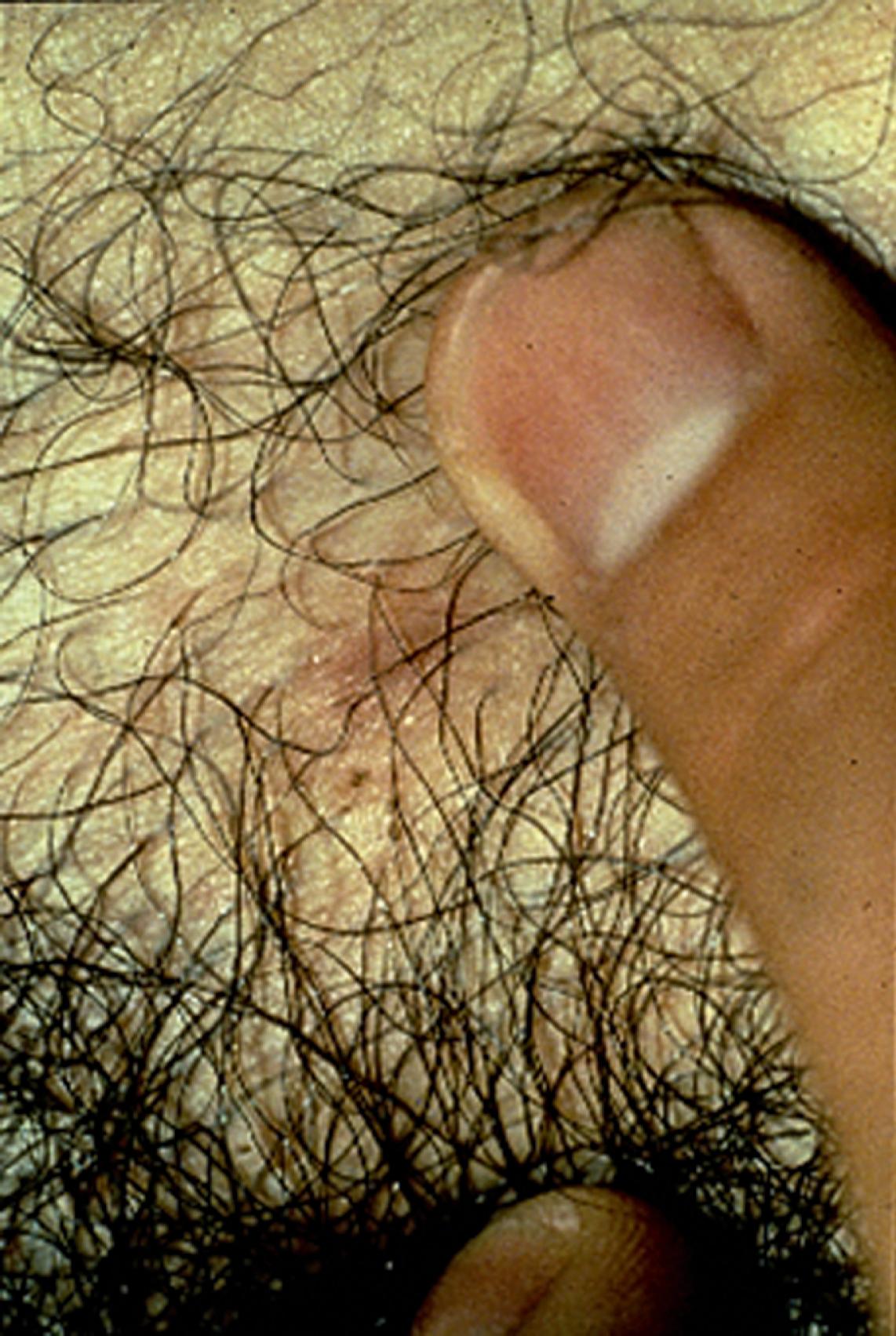
The diagnosis is made by finding lice or nits in the hair or seams of clothing ( Figs. 257.2–257.5 ).
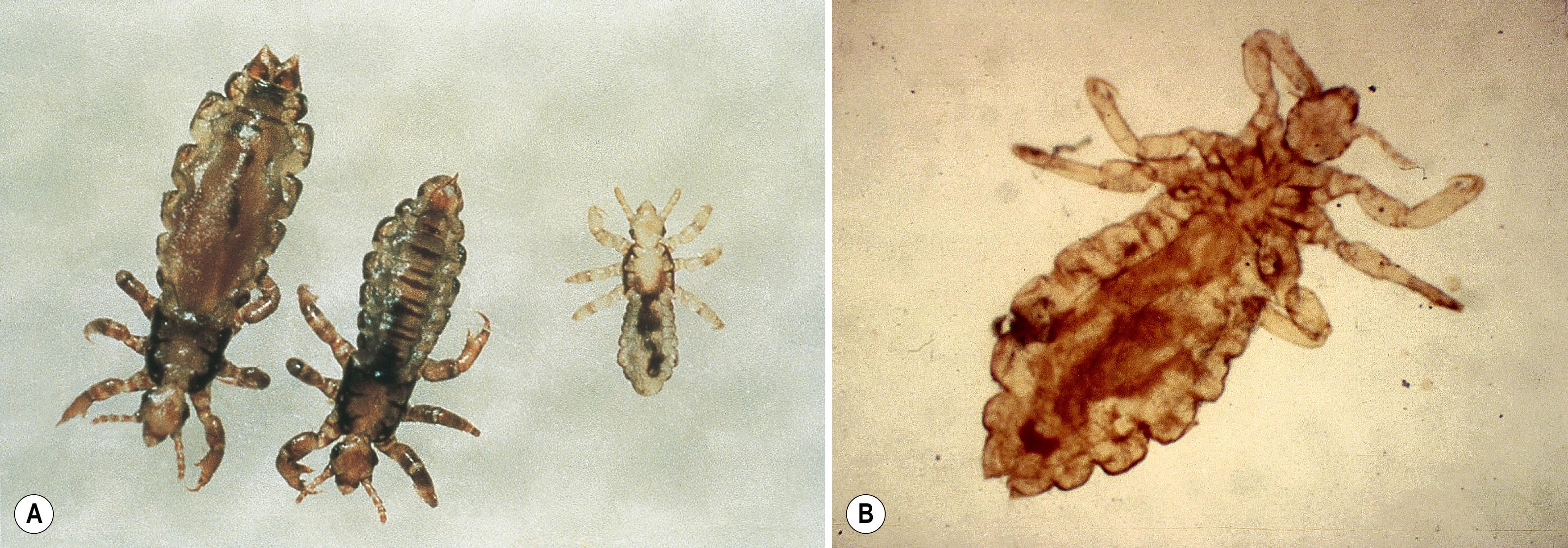
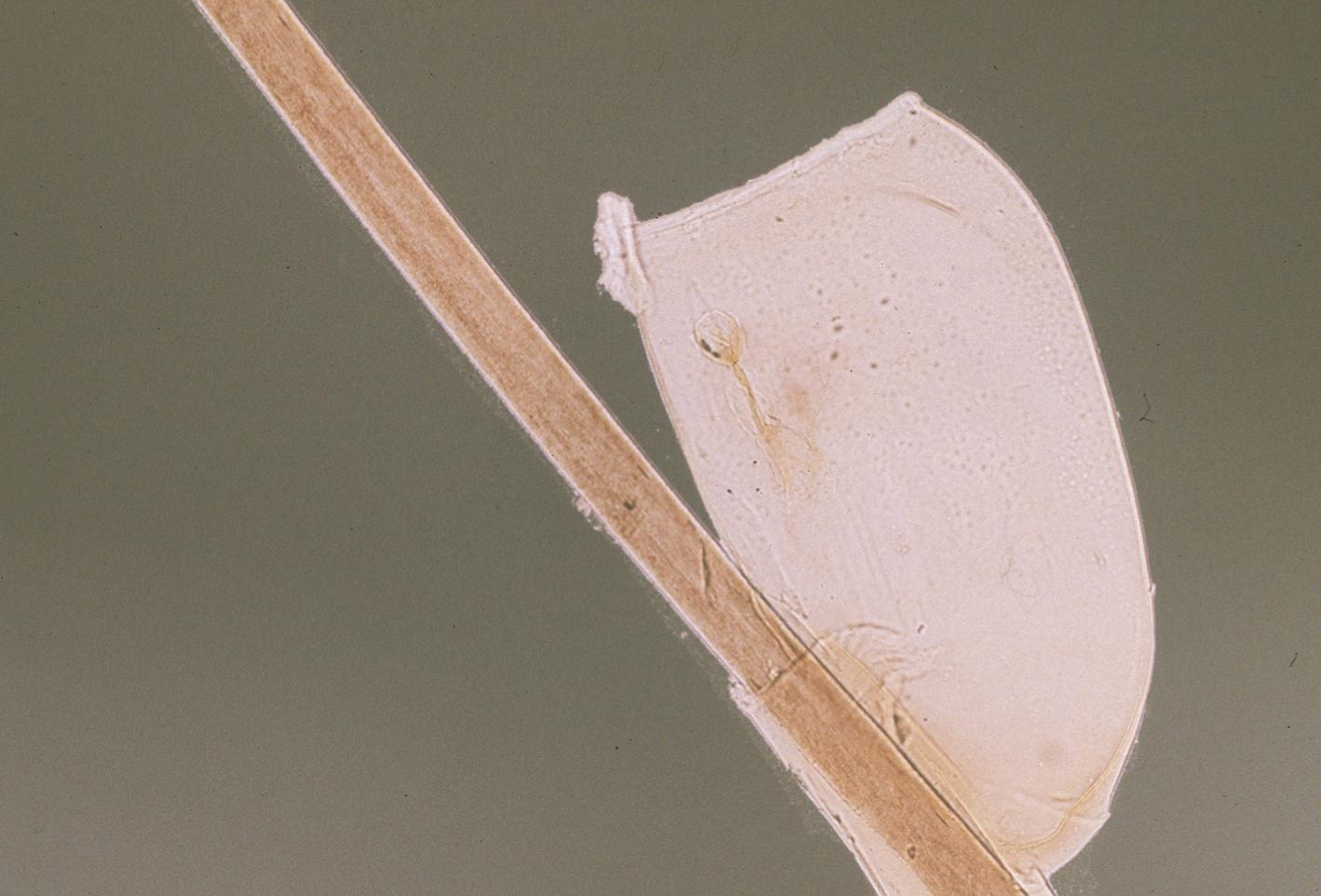
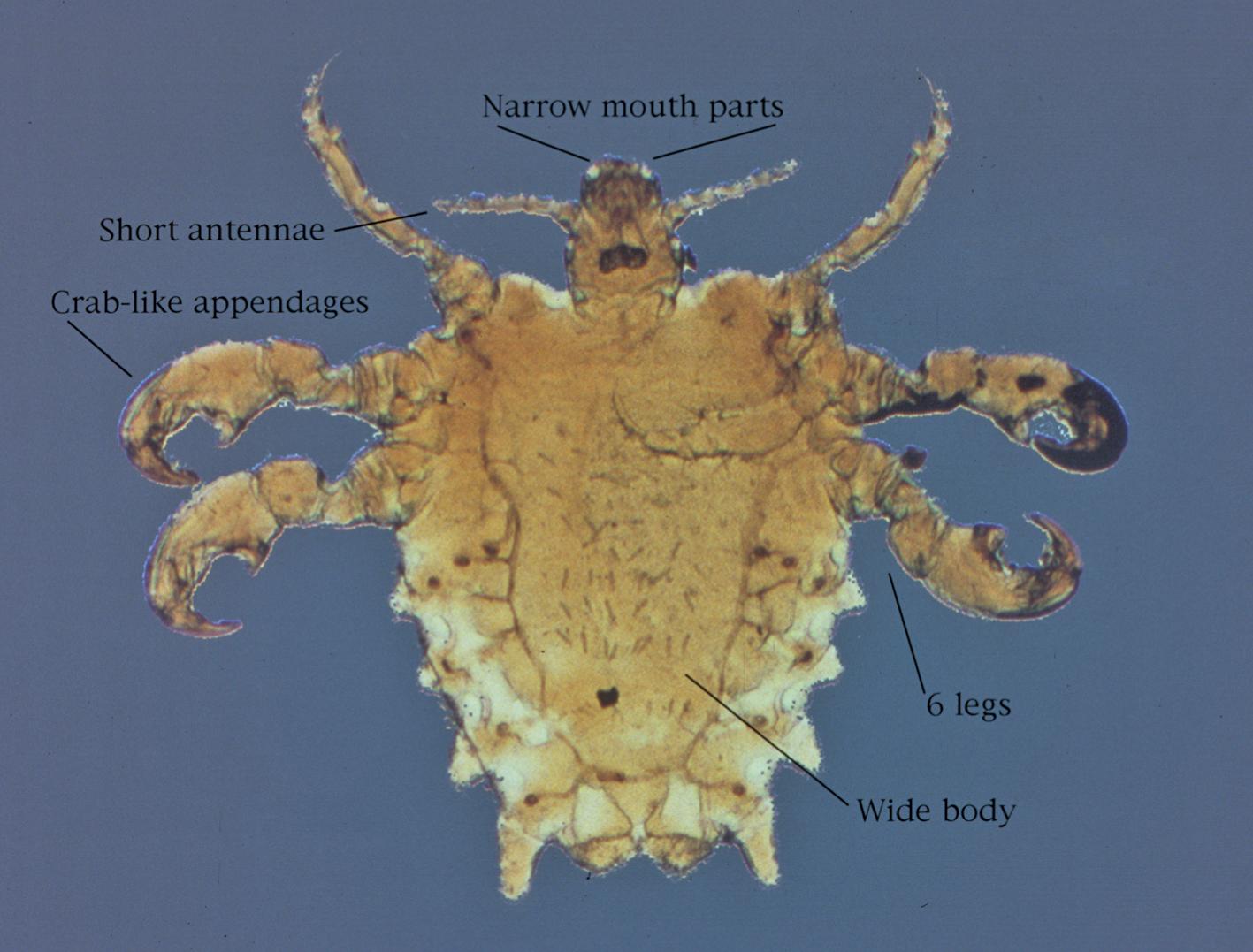
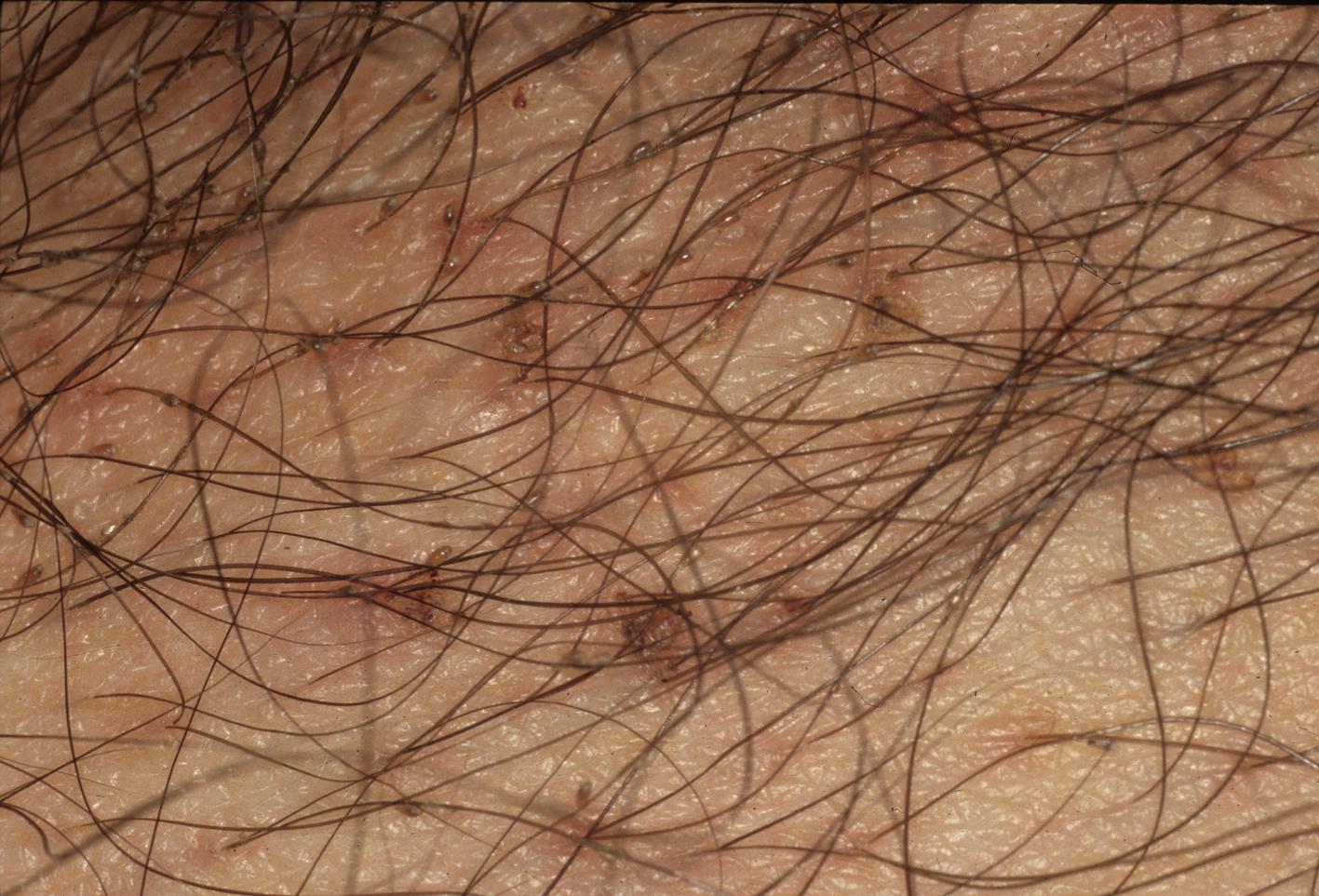
Shaving of all parasitized hair will eradicate head and pubic lice but is not cosmetically acceptable in most societies. Mechanical removal via wet-combing is labor-intensive and compliance is poor. Dilute solutions of vinegar or formic acid are not capable of dissolving nit cement but can facilitate combing by flattening the hair cuticle.
Topical products ( Table 257.1 ) are recommended treatment for louse infestations. Repeat application of topical agents at 7 days is generally recommended for all listed agents, but recent evidence suggests that ova can take as long as 13 days to hatch, suggesting that 3 total applications at weekly intervals may be optimal.
| Name | Evidence a | Instructions for Use | Precautions |
|---|---|---|---|
| Topical Treatments Labeled For The Treatment of Pediculosis b | |||
| First Line | |||
| Benzyl alcohol | IB | Apply topically to dry scalp for 10 minutes, then rinse off | Allergic/irritant dermatitis |
| Second Line | |||
| Spinosad Topical ivermectin Permethrin 1% |
IB IB IA |
Apply topically to dry scalp for 10 minutes, then rinse off Apply topically to dry scalp for 10 minutes, then rinse off Apply topically to dry scalp for 10 minutes, then rinse off |
Irritant dermatitis/eye irritation Irritant dermatitis/eye irritation Allergic/irritant dermatitis |
| Pyrethrins | IIB | Apply topically to body or dry scalp for 5–10 minutes then rinse off | Allergic/irritant dermatitis |
| Malathion | IB | Application schedule varies by vehicle | Respiratory depression |
| Treatments For Scabies | |||
| First Line | |||
| Permethrin 5% | IA | Apply topically c | Risk of leukemia |
| Precipitated sulfur | IIB | Apply topically c | Offensive odor |
| Benzyl benzoate | IB | Apply topically c | Neurotoxicity |
| Ivermectin | IB | 200 μg/kg orally | Neurotoxicity |
| Second Line | |||
| Crotamiton | IIA | Apply topically c | Marginal efficacy |
a Levels of evidence: IA, meta-analysis of randomized controlled trials; IB, at least one randomized controlled trial; IIA, at least one controlled study without randomization; IIB, at least one other type of quasi-experimental study.
b Most labels indicate a repeat application at 1 week, but recent evidence suggests a second application may needed in many patients at 2 weeks.
c The cream should be applied to the entire body, including the head in infants. Care should be taken to apply a thick coat under the nails, in the umbilicus, axillae, web spaces, wrists, ankles, and genitalia. Close contacts should be treated concurrently.
Benzyl alcohol lotion is approved for children ≥6 months of age. The quantity applied must be sufficient to saturate the hair completely for 10 minutes. Phase III randomized trials comparing benzyl alcohol with a vehicle placebo for two 10-minute applications showed benzyl alcohol to be safe and effective (P < .001). Toxicity has been reported with intravenous exposure to benzyl alcohol in neonates and low birthweight infants. The gasping syndrome (characterized by central nervous system depression, metabolic acidosis, and gasping respirations) has been associated with benzyl alcohol dosages >99 mg/kg/day. The product label indicates that benzyl alcohol level was quantified in a single plasma sample in 4 of 19 subjects after topical application, including 3 subjects in the age group of 6 months to 3 years 30 minutes posttreatment. Levels ranged from 1.97–2.99 μg/mL, levels unlikely to produce toxicity. With topical use, benzyl alcohol can induce histamine release and produce scalp itching and eye irritation. Acceptable daily intakes have been established by the World Health Organization at 5 mg/kg.
Spinosad 0.9% topical suspension is a novel parasite neurotoxin indicated for the treatment of head lice in children ≥6 months of age. It contains a mixture of spinosyn A and spinosyn D in a ratio of approximately 5:1. The active ingredient is derived from the fermentation of a soil actinomycete bacterium, Saccharopolyspora spinosa. The suspension is applied for a 10-minute application. The suspension contains benzyl alcohol, which may contribute to the product’s efficacy. The product label indicates that benzyl alcohol level was quantifiable (>1 μg/mL) following application in 6 of 26 subjects, including in 4 of 12 subjects in the age group of 6 months to <2 years. The highest observed concentration was 2.37 μg/mL, a range similar to that observed after topical Ulesfia application.
Ivermectin lotion is indicated for the topical treatment of lice in children >6 months of age, with a single 10-minute application comparing favorably with ivermectin orally. Adverse effects include skin and eye irritation. Ivermectin is derived from the fermentation of a soil-dwelling actinomycete, Streptomyces avermitilis . Absorption of ivermectin was evaluated in 20 lice infested subjects (13 weighing ≤15 kg). The mean plasma maximum concentration (0.24 ± 0.23 ng/mL) measured was far lower than that observed following oral administration.
Pyrethrins are botanically derived pediculicides that act as parasite neurotoxins. Piperonyl butoxide typically is added to potentiate the insecticidal effect. Allergic contact dermatitis can occur in people who are sensitive to Compositae plants and ragweed.
Permethrin is a synthetic pyrethroid neurotoxin available over the counter as a 1% cream rinse. Permethrin acts on sodium-gated channels resulting in paralysis (knockdown) and subsequent death of the louse. Knockdown resistance is now widespread and identified readily via gene mutation or lack of initial immobilization. Resistance to permethrin commonly crosses over to pyrethrins as well as to the other pyrethroids.
Malathion is a weak organophosphate cholinesterase inhibitor that acts as a parasite neurotoxin. Currently, malathion resistance in the US is rare, but it is more common in the UK. Although malathion is labeled for use in patients ≥6 years of age, recent studies showed no cholinesterase inhibition in patients 2–6 years of age. Flammability of malathion preparations compounded in isopropyl alcohol has resulted in human injury in approximately 1 instance per >1 million prescriptions filled. Efficacy for eradication of louse infestation in the U.S. is 97%–98%.
Carbaryl is a carbamate insecticide once used commonly in the UK, where over-the-counter sales have been restricted because of concerns about carcinogenicity. Acetylcholinesterase-based resistance is emerging.
Become a Clinical Tree membership for Full access and enjoy Unlimited articles
If you are a member. Log in here